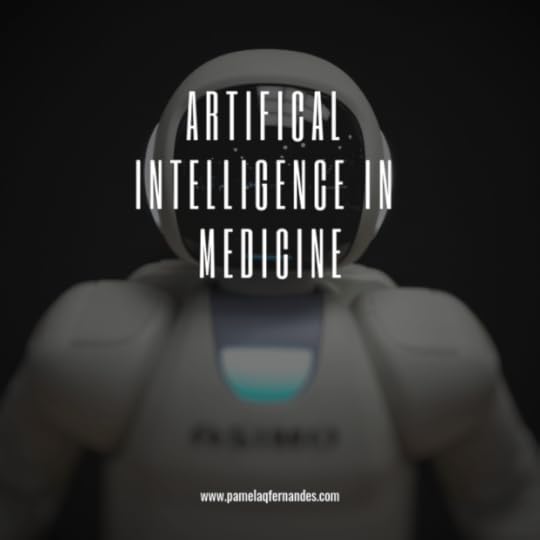ARTIFICIAL INTELLIGENCE IN MEDICINE-Yay or Nay
I had this question in my inbox for a while. “What do you think about artificial intelligence in medicine?” Well, a month ago I would have scoffed at the idea. Then I interviewed Dr Richard Do, prominent radiologist at MSKCC for Radiology Today. He said something that completely shifted my mindset.
“It’s all about data,” he said. “A single pathology slide has far more data than an entire CT. The more data you have the better that machines can work with it.” He’s right. Most medicine is data. What we do is take data we know and extrapolate it to current conditions. That’s what clinical trials are and that’s exactly what we can train artificial intelligence to do.

More of us need to start thinking like him. In many areas today, research has stalled at the genetic level. At present, it’s very difficult to treat at this level even if we make astonishing discoveries. Most of our macro level issues are patient compliance, longer wait times, the dearth of doctors, having untrained people prescribe and administer healthcare. Just yesterday, The Daily Mail reported that pharmacists were going to dispense medication due to the unavailability of staff in the NHS. We know how pharmacies operate and in the end it’s going to end up being about the money.
So Artificial Intelligence seems to be a good option at the moment.
ARTIFICIAL INTELLIGENCE IN RADIOLOGY
Radiology is already considering it’s next generation tools in AI. Whethere that’s patterned learning through texture or radiomics, they’re now trying to study virtual biopsies. How? In the area of cancer research, AI can study each pixel of tumors and then determine the malignancy potential through a series of mathematical calculations and algorithms. There’s already been some success with this in colorectal and breast cancer.
Machine learning and deep learning can help diagnose and dictate canacer treatments. This is going to get better with increasing datasets i.e more CT’s, MRI’s, mammograms and ultrasounds. Although, with neural networks, data shows that with multiple images the networks can sometimes “hallucinate.” This can be dangerous and requires a lot more work before application. I’d love to explain all this but I’m not a radiologist. So if you want to know more about radiomics, you’ll have to check this out.
Similarly, a research scholar from the University of Washington won the Paul Baran Young Scholar Award for 2018. She used smartphones to detect life-threatening symptoms. The idea came from bats who use sonar to detect in the dark. Using the very same principles of acoustics, movement and respiration can also be tracked via smartphones. AI in radiology looks promising. Every year there are plenty of new ideas coming to the fore. And with not a lot capital required, radiologists have warmed to the idea themselves. In fact, smaller tasks like measuring changes of lung nodules or size of multiple sclerosis lesions may be automated in the future.
ARTIFICIAL INTELLIGENCE IN OB/GYN
In OB/GYN big data has already positively impacted to breast and ovarian cancer. However, artificial intelligence for detecting preterm uterine activity successfully and accurately identified spontaneous preterm labor. Doctors used electrohysterography signals to detect preterm births, as they provide a strong basis for objective prediction and diagnosis of preterm birth. They used three different machine learning algorithms to identify women with premature births in the records. The results revealed that the Random Forest Algorithm performed the best of sensitivity 97 and specificity of 85%. Area under the Receiver Operator curve (AUROC) of 94% and mean square error rate of 14%.
Similarly, advanced AI-powered EFM with push-button reporting can notify clinicians about patients when conditions are worsening. Early-warning systems, like them are highly effective as they continuously analyze fetal heart rate, contractions, and labor progression, and maternal vital sign alerts. A study showed that with the Maternal Early Warning Trigger (MEWT) tool reduced maternal mortality. Particularly, in these 4 most common areas of maternal morbidity: sepsis, cardiopulmonary dysfunction, preeclampsia-hypertension, and hemorrhage.
ARTIFICIAL INTELLIGENCE IN PATHOLOGY
There was an article a couple of years ago about Pathology and AI becoming frenemies. In the end, it concluded that AI and Pathology were natural co-operators. No one is talking about replacing pathologists. But in the last few years, it’s been clear that AI can improve the productivity of pathologists. Google’s LYNA algorithm proved it could increase speeds in analyzing stained lymph node slides and sensitivity of micrometastases detection in recent studies. Pathology is rich in datasets.
In another project, Dr. Lundin, associate professor for biomedical informatics and research director at the Institute for Molecular Medicine Finland (FIMM) makes the diagnosis directly from an image for risk prediction. No pathologist was needed. They trained a classifier, as in cancer, with images of tissue and used patient outcome as an endpoint in the AI training process. The algorithm machine simply learns the patterns of images, but outperforms experienced pathologists in predicting patient outcome. How cool is that? 



